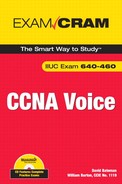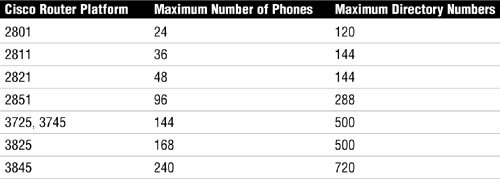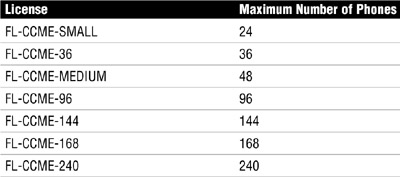Techniques you need to master:
Cisco offers a number of IP telephony call control products and applications. Cisco Unified Communications Manager Express (CME) is the call control system that the test focuses on. This chapter offers an introduction to the features, hardware, and software that Cisco Unified CME supports.
The Cisco Unified CME is attractive to customers for a number of reasons. The Cisco Unified CME system offers cost benefits as well as advanced features that are beneficial for small- to medium-sized companies.
Cisco Unified CME is considered an entry-level solution in part because its topend capacity is 240 phones. The term entry-level should not lead you to believe that it is limited in features. It is normally a perfect fit for small companies and branch offices. It is a complete standalone telephony system that offers each site the ability to manage its own needs.
Exam Alert
The Cisco Unified CME uses a multiservice or integrated services router as its hardware platform. As the name implies, this device can also be used for other services such as routing, firewall, quality of service (QoS), video, and XML.
Also, because it runs on a Cisco router, you can leverage existing IOS knowledge to manage it using the command-line interface (CLI). The system can also be configured using a graphical user interface (GUI), but those who are used to the CLI might find it a more efficient way to perform many administrative tasks.
Another benefit of Cisco Unified CME running on a router is the total cost of ownership (TCO) of using a single device to handle many network services.
Cisco Unified CME offers most of the features that the typical small- and medium-sized business users are familiar with. However, it also offers more advanced features that these companies might not have been able to take advantage of previously. The following sections look at the features offered in four different areas: phone, system, trunk, and voicemail.
The phone features available to the user can vary based on the model of phone. The following are the features that you should be familiar with. Each of the following features is available on many of the phone models:
![]() Enhanced 911 services.
Enhanced 911 services.
![]() Media encryption using Secure Real-Time Transport Protocol (SRTP).
Media encryption using Secure Real-Time Transport Protocol (SRTP).
![]() Ability to log in to a phone (Extension Mobility).
Ability to log in to a phone (Extension Mobility).
![]() XML services on certain Cisco IP phones.
XML services on certain Cisco IP phones.
![]() Up to 240 phones per system.
Up to 240 phones per system.
![]() On-hook dialing.
On-hook dialing.
![]() Local directory lookup.
Local directory lookup.
![]() Configurable ringers.
Configurable ringers.
![]() Message Waiting Indicator (MWI) (light and or icon).
Message Waiting Indicator (MWI) (light and or icon).
![]() Customization of softkeys.
Customization of softkeys.
![]() Do Not Disturb (DND) feature to divert calls directly to voicemail.
Do Not Disturb (DND) feature to divert calls directly to voicemail.
![]() DND state display.
DND state display.
![]() Enable and disable call-waiting notification for each line.
Enable and disable call-waiting notification for each line.
![]() Monitor-line button speed dial. A monitor line monitors the status of another phone and can also be used as a speed dial. When used as a speed dial, it is also referred to as a direct station select.
Monitor-line button speed dial. A monitor line monitors the status of another phone and can also be used as a speed dial. When used as a speed dial, it is also referred to as a direct station select.
![]() Speed dial and last-number redial.
Speed dial and last-number redial.
![]() Analog phones and fax machines are supported using the Cisco Analog Telephone Adaptor 186 (ATA 186) and ATA 188.
Analog phones and fax machines are supported using the Cisco Analog Telephone Adaptor 186 (ATA 186) and ATA 188.
In addition, some phone models offer additional features, as follows:
![]() 7911 and 7931G support Audible Message Line Indicator.
7911 and 7931G support Audible Message Line Indicator.
![]() 7960G and 7961G can support six line appearances.
7960G and 7961G can support six line appearances.
![]() 7970G and 7971G-GE can support eight line appearances.
7970G and 7971G-GE can support eight line appearances.
![]() Add a number of lines to an attendant’s phone by adding a 7914 (14-button sidecar) to any of the following phones: 7940G, 7941G, 7960G, or 7961G.
Add a number of lines to an attendant’s phone by adding a 7914 (14-button sidecar) to any of the following phones: 7940G, 7941G, 7960G, or 7961G.
![]() Display custom URL on the screen of the phone when idle, also known as Idle URL. The 7940G, 7941G, 7960G, 7961G, 7970G, and 7971G models include this feature.
Display custom URL on the screen of the phone when idle, also known as Idle URL. The 7940G, 7941G, 7960G, 7961G, 7970G, and 7971G models include this feature.
The following is a list of system features. Most are self-explanatory; for those that are not, a brief description is offered.
User-facing features:
![]() Consultation call transfer: Lets the party you are transferring to know who is calling.
Consultation call transfer: Lets the party you are transferring to know who is calling.
![]() Blind call transfer: Transfer the call without speaking to the transferred party.
Blind call transfer: Transfer the call without speaking to the transferred party.
![]() Call hold and call retrieve.
Call hold and call retrieve.
![]() Call pickup of on-hold calls.
Call pickup of on-hold calls.
![]() Call waiting.
Call waiting.
![]() Paging.
Paging.
![]() Intercom.
Intercom.
![]() Extension assigner: Allows the addition of an extension by someone who does not have administrative rights.
Extension assigner: Allows the addition of an extension by someone who does not have administrative rights.
![]() Music on hold (MOH) and music on transfer for external calls: Internal callers hear a tone when placed on hold or transfer.
Music on hold (MOH) and music on transfer for external calls: Internal callers hear a tone when placed on hold or transfer.
![]() Different rings for internal and external calls.
Different rings for internal and external calls.
![]() System speed dial.
System speed dial.
![]() Directory services.
Directory services.
System-side features:
![]() MOH: The audio source is a file on the router.
MOH: The audio source is a file on the router.
![]() MOH live feed: The source is a live feed such as a CD.
MOH live feed: The source is a live feed such as a CD.
![]() Interoperability with Cisco Unified Contact Center Express.
Interoperability with Cisco Unified Contact Center Express.
![]() Signaling encryption.
Signaling encryption.
![]() Conferencing capabilities: Hardware and software.
Conferencing capabilities: Hardware and software.
![]() International language support: German, French, Italian, and Spanish.
International language support: German, French, Italian, and Spanish.
![]() GUI administrative access for moves, adds, and changes through a web browser.
GUI administrative access for moves, adds, and changes through a web browser.
![]() Interactive voice response (IVR) Auto Attendant.
Interactive voice response (IVR) Auto Attendant.
![]() Class of restriction (COR) to restrict calling capabilities.
Class of restriction (COR) to restrict calling capabilities.
![]() Inline power for IP phones.
Inline power for IP phones.
![]() Call transfer and call forwarding (standards-based: H450.2 and H450.3).
Call transfer and call forwarding (standards-based: H450.2 and H450.3).
![]() Computer telephony integration (CTI) support with Telephony Application Programming Interface (TAPI) Lite: Allows things such as dial from Outlook.
Computer telephony integration (CTI) support with Telephony Application Programming Interface (TAPI) Lite: Allows things such as dial from Outlook.
![]() Call detail record (CDR) generation through RADIUS.
Call detail record (CDR) generation through RADIUS.
![]() Cisco and NetCentrex gatekeepers support.
Cisco and NetCentrex gatekeepers support.
![]() Hookflash pass-through to a central office (CO) for analog phones.
Hookflash pass-through to a central office (CO) for analog phones.
![]() Date and time synchronization with Network Time Protocol (NTP).
Date and time synchronization with Network Time Protocol (NTP).
![]() Longest-idle hunt group.
Longest-idle hunt group.
![]() Hunt group dynamic login and logout.
Hunt group dynamic login and logout.
![]() Hunt group statistics.
Hunt group statistics.
![]() Caller ID display for hunt group.
Caller ID display for hunt group.
![]() Called name directory lookup for Dialed Number Identification Service (DNIS).
Called name directory lookup for Dialed Number Identification Service (DNIS).
![]() Called name display for overlay dialed number (DN).
Called name display for overlay dialed number (DN).
![]() Conference initiator drop-off: Can configure whether a conference call stays active after the initiator hangs up.
Conference initiator drop-off: Can configure whether a conference call stays active after the initiator hangs up.
![]() Consultative transfer when transferring using direct station select.
Consultative transfer when transferring using direct station select.
![]() The night service notification can repeat every 12 seconds.
The night service notification can repeat every 12 seconds.
![]() Translation-profile support for ephone-dn.
Translation-profile support for ephone-dn.
The trunk features have grown as the Cisco Unified CME product has matured. The following is a list of trunk features:
![]() Direct Inward Dialing (DID) and Direct Outward Dialing (DOD).
Direct Inward Dialing (DID) and Direct Outward Dialing (DOD).
![]() BRI and PRI support for all switch types that Cisco IOS supports.
BRI and PRI support for all switch types that Cisco IOS supports.
![]() Caller identification display and blocking, calling name display, and automatic number identification support.
Caller identification display and blocking, calling name display, and automatic number identification support.
![]() DID for Foreign Exchange Office (FXO) trunks.
DID for Foreign Exchange Office (FXO) trunks.
![]() T1 and E1 trunk support.
T1 and E1 trunk support.
![]() Frame Relay, ATM, Multilink PPP (MLP), and DSL support for WAN links.
Frame Relay, ATM, Multilink PPP (MLP), and DSL support for WAN links.
![]() H.323 network calls.
H.323 network calls.
![]() Map a phone button directly to a dedicated trunk.
Map a phone button directly to a dedicated trunk.
![]() H.323 to Session Initiation Protocol (SIP) call routing to Cisco Unity Express.
H.323 to Session Initiation Protocol (SIP) call routing to Cisco Unity Express.
![]() SIP trunks support RFC 2833.
SIP trunks support RFC 2833.
![]() Transcoding.
Transcoding.
Note
The features included in this list were current at the time of this writing. Visit the Cisco Unified CME website for information about any feature changes: http://www.cisco.com/en/US/products/sw/voicesw/ps4625/products_data_sheets_list.html.
You can integrate Cisco Unified CME with a number of voicemail systems. The CCNA Voice Exam focuses on the integration with Cisco Unity Express, which is discussed in Chapter 11, “Configuring Cisco Unity Express.” In addition to integrating with Unity Express, Cisco Unified CME can also integrate with Unity Express using Skinny Client Control Protocol (SCCP) integration. It can also integrate with a number of third-party voicemail systems through H.323 or dual tone multifrequency (DTMF) signaling.
As stated earlier in the section “Understanding the Benefits of Cisco Unified CME,” Cisco Unified CME runs on a Cisco router. The following sections take a closer look at exactly which routers it runs on as well as other requirements such as memory, software, and licensing.
The supported router platforms for Cisco Unified CME 4.2 are the Cisco 2800 and 3800 series integrated services routers and the Cisco 3700 series multiservice router. These routers are available in a number of configurations, and the exact configuration you order depends on what additional functions you want the router to perform. For example, you might want an integrated switch module or a T1 port.
Tip
When determining which router you are going to use, make sure to use the Cisco online configuration tool. This tool can help verify that all the required components will work in the selected router.
In addition to the interface modules that you need, you must also ensure that there is enough RAM and flash memory in the router to support Cisco Unified CME and any other functions you want the router to perform.
Exam Alert
Cisco Unified CME requires a minimum of 64MB flash and 256MB RAM when installed on a Cisco 2800, 3800, or 3700 series router.
The minimum memory requirements are for Cisco Unified CME only, and more memory must be added for additional functions.
When selecting the platform, make sure that it can support the number of endpoints and directory numbers you are going to have in your environment. Each platform has its own limitations, as shown in Table 9.1.
After you have determined the hardware platform, you need to make sure that you have the proper Cisco IOS Software. To support Cisco Unified CME 4.2, Cisco IOS Release 12.4-11XW6 with the IP voice feature set is required. After you have the proper IOS loaded, you need to load the Cisco Unified CME software. You can obtain the Cisco Unified CME software from Cisco.com. You need to install the base Cisco Unified CME files at a minimum. You might also want to install additional software such as the GUI files, which allow you to administer the system from a web browser, and phone firmware files.
A license is also required. While the platform you choose determines the maximum number of phones and directory numbers that can be supported, the license determines how many you can actually have installed and working. Table 9.2 lists the licenses that are available and the number of phones that each supports.
When you order a license, you can order based on your current needs. You can upgrade these licenses because they are cumulative. For example, if you have an FL-CCME-36 license and add an FL-CCME-SMALL license, you are licensed for a total of 60 phones.
Cisco Unified CME 4.2 supports several types of endpoints. The following is a list of the phones that are supported broken down into three categories: entry-level, mid-level and high-end:
![]() Entry-level phones:
Entry-level phones:
![]() Mid-level phones:
Mid-level phones:
![]() 7931G
7931G
![]() 7940G
7940G
![]() 7941G
7941G
![]() 7941G-GE
7941G-GE
![]() 7942G
7942G
![]() 7945G
7945G
![]() 7960G
7960G
![]() 7961G
7961G
![]() 7961G-GE
7961G-GE
![]() 7962G
7962G
![]() High-end phones:
High-end phones:
![]() 7965G
7965G
![]() 7970G
7970G
![]() 7971G
7971G
![]() 7975G
7975G
In addition to these phones, a number of devices that are also supported by Cisco Unified MCE 4.2 fall into a miscellaneous category. They are as follows:
![]() 7985G: Videophone
7985G: Videophone
![]() 7920 and 7921G: Wireless phones
7920 and 7921G: Wireless phones
![]() 7914:14-button sidecar that can be attached to a 7960 series phone
7914:14-button sidecar that can be attached to a 7960 series phone
![]() 7936 and 7937G: Conference phone (Polycom)
7936 and 7937G: Conference phone (Polycom)
|
1. |
D. Cisco Unified CME does not run on lower-end routers such as the Cisco 2600. Answer A is incorrect because Cisco Unified CME can help reduce TCO. Answer B is incorrect because you can leverage your existing IOS knowledge. Answer C is incorrect because UCME does support up to 240 phones. |
|
2. |
A, B, C, and D. Cisco Unified CME does support DND, call waiting, on-hook dialing, and XML services. Answer E is incorrect because flash tone is not a feature. |
|
3. |
B. Cisco Unified CME does support music on hold, Auto Attendant, standards-base call transfer, and recording of call details. Answer A is incorrect because Cisco Unified CME uses H.450 standards for call transfer. Answer C is incorrect because Cisco Unified CME has an Auto Attendant feature. Answer D is incorrect because Cisco Unified CME supports CDR through RADIUS but does not require a third-party package. |
|
4. |
B. Automatic number diversion is not a trunk feature. Answer A is incorrect because automatic number diversion is not a trunk feature. Answer C is incorrect because DID is supported on FXOs. Answer D is incorrect because SIP trunks are currently supported. |
|
5. |
A, C, and E. The Cisco 2811, 2821, and 2851 routers are supported platforms for Cisco Unified CME. Answers B and D are incorrect because 2822 and 2855 are not valid router model numbers. |
|
B and E. The FL-CCME-SMALL license is a license for 24 phones, and the 2811 is required because the 2801 only supports 24 phones. Answer A is incorrect because FL-CCME-MED is not a valid license. Answer C is incorrect because FL-CCME-24 is not a valid license. Answer D is incorrect because an FL-CCME-10 is not a valid license. |
|
|
7. |
C. A Cisco 3825 router with 64MB flash and 512MB RAM can support 144 phones, and the FL-CCME-144 is a 144-phone license. Answer A is incorrect because a Cisco 2851 router only supports 96 phones. Answer B is incorrect because you need a minimum of 256MB RAM to support Cisco Unified CME. Answer D is incorrect because a Cisco 2851 router only supports 96 phones. |
|
8. |
E. UCME 4.2 is not supported on the 3640. Answers A, B, C, and D are incorrect because UCME 4.2 is not supported on the 3640. |
|
9. |
B. A monitor-line button can monitor the status of the line. Answer A is incorrect because the monitor-line button cannot monitor a voice stream. Answer C is incorrect because the monitor-line button cannot monitor a video stream. Answer D is incorrect because the monitor-line button has nothing to do with voicemail. |
|
10. |
C. The 3825 can support 168 phones. Answer A is incorrect; the 2851 supports 96 phones. Answer B is incorrect; the 3725 and 3745 support 144 phones. Answer D is incorrect; the 3845 supports 240 phones. |


